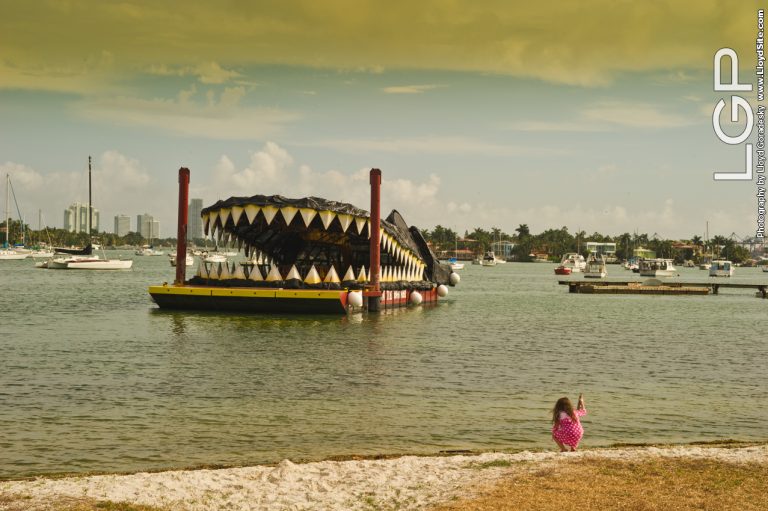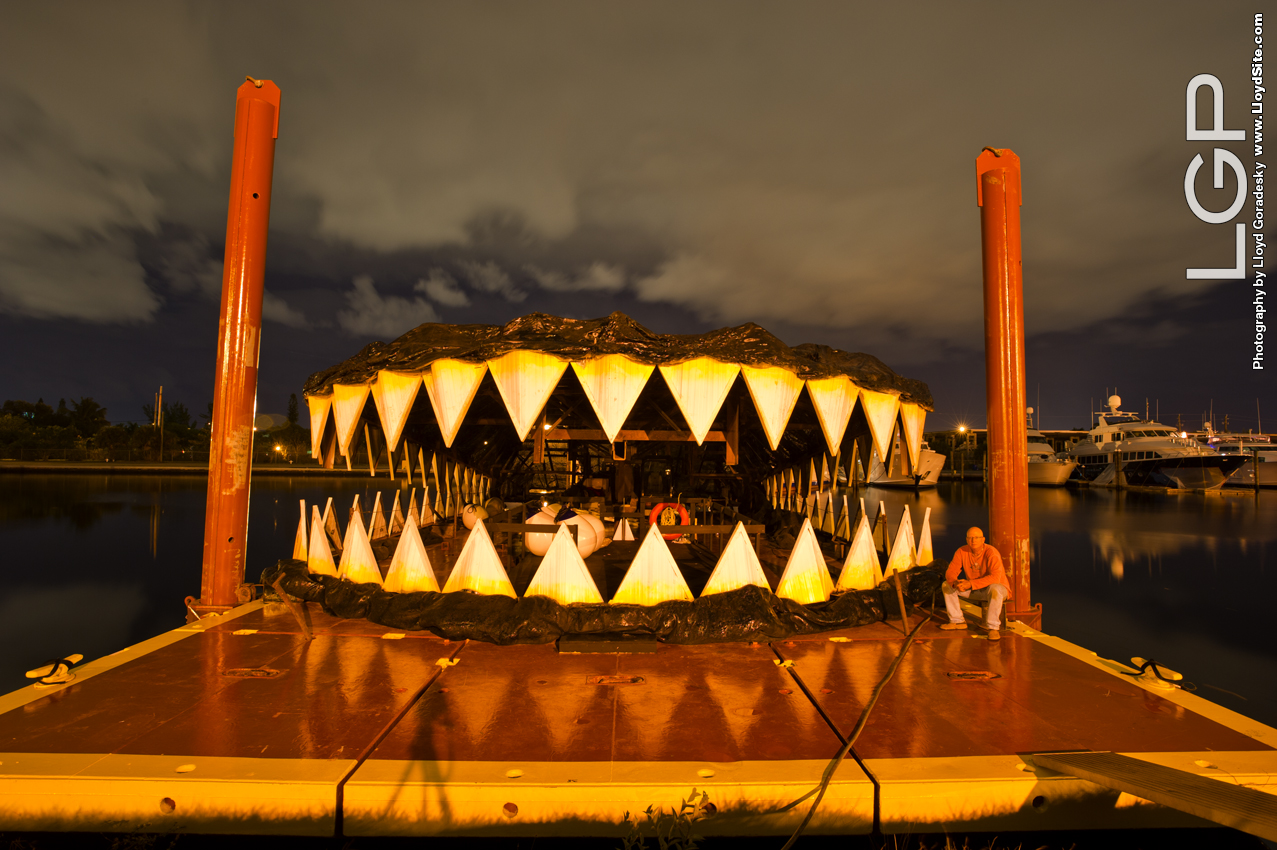


‘Gator in the Bay’ is a 33,000 pound alligator the size of a football field that floats. The head is a 3-story steel sculpture built on a self-propelled barge using recycled junkyard materials, . The upper jaw attached to the boom of a crane, opens and closes, The body is made of 104 individual boards (called Floating Art Tiles) displaying photographs of the Everglades (captured by the artist) which took four years and $1 million to complete.
Each Floating Art Tile has over 3000 unique images of the Florida Everglades that are the size of a postage stamp. The entire illusion of the alligator body is created using over 300,000 images with over 83,000 unique images of the Florida Everglades photographed by Goradesky.
Goradesky’s artistic invention, Floating Tile ArtTM, is an example of a new medium in art that is unique. Using the SCALGIOTM process to print on highly buoyant boards, Goradesky has created a wonderful way to display art on water.
Using the Power of Art to bring awareness to our natural surroundings, Goradesky’s art extends from muti-media design to complex photographic creations. His artistic goal is to get the viewer to look through the actual art piece and to interpret the meaningful message. His personal goal is to create the world’s largest assembled photograph.
Gator in the Bay is a complete art exhibit that includes books, tshirts, posters, project diagrams, hats and mixed media art. The art has been compared to Christo’s Surrounded Islands and is a wonderful experience.
The Gator travelled around the world via News Media. The Gator in the Bay was featured in over 30 foreign newspapers’ front page, interviewed by ABC, CBS, NBC, NPR, CNN, Fox News, Yahoo News, Discovery Channel, Huffington Post, The Examiner, Sun Sentinel, and the Miami Herald. A photo of Gator in the Bay – Phase 1 unveiled during Art Basel Miami 2012 was used to promote Art Basel Hong Kong. During Art Basel 2012, Lambeth & Nagel estimate over $8 million in media advertising was generated as a result of Gator in the Bay. During Art Basel Miami 2013, the body was attached to the head, the Gator in the Bay was completed and again received worldwide attention as the world’s largest alligator.
The Gator in the Bay has earned a list of worldwide accolades. The Gator in the Bay is internationally recognized and recommended as a must see art exhibit. With over 8 million local viewers in South Florida, the Gator participated in the Seminole Winterfest Boat Parade. For two consecutive years, during Winterfest 2012 and Winterfest 2013, Gator in the Bay won the People’s Choice Award!

Where do you go to build a Gator?
The Gator in the Bay was built by V&M Erectors, Pembroke Pines, Florida.
V&M Erectors supplied trucks, cranes, lifts, steel & materials; they provided unlimited manpower and the funding to capture the iconic photographs.
V&M Erectors specialize in steel bridge structures all over the world. V&M Erectors has accumulated a list of accolades from their worldwide projects that have spanned over 25 years.
There is no manual to follow on how to create a large scale public art piece.
The Maiden Voyage
After four years of planning, the excitement of the first voyage of the world’s largest gator was shared with Marie Nix, co-owner of V&M Erectors, on December 5th, 2012.
The effort to build an International art piece requires the skills, expertise, and cooperation of hundreds of individuals.
Thank you to the entire staff of V&M Erectors, Fronte Crane and the Nix Family for taking a personal interest to help raise awareness to save our Florida Everglades.





Alligators have Sharp Teeth
Alligators generally have 80 uniform teeth. If a tooth is lost from use or aging, they are regrown. An alligator will use almost 3,000 teeth in their lifetime.
There are 70 teeth on the Gator in the Bay. The teeth are made from corrugated roofing and trailer siding material found in junkyards and landfills. Each tooth weighs 40 pounds and is 4 feet wide by 4 feet long.
Waddy Thompson (top right), Materials Engineer, procured all recycled and landfill materials for the project.
The Gator is Environmentally Conscious
The Poseidon barge is eco-friendly using biodiesel fuel and a spud anchoring system that minimizes sea grass and bottom damage. The barge used to float the Gator is 30 feet wide and 70 feet long. The barge is designed for marine construction complete with marine cranes and generators. The barge was disassembled to accommodate the steel frame of the Gator head. Two steel beams were welded to the top of the barge that extended 20 feet past the stern completing the length of the Gator’s head to 90 feet.
The barge to float the Gator was provided by Fronte Crane Services, Fort Lauderdale, Florida.







“My goal was to capture an iconic image of South Florida – my hometown, so I built the world’s largest alligator.“
– Lloyd Goradesky, The Artist
‘Gator in the Bay’ is a 33,000 pound alligator the size of a football field that floats. The head is a 3-story steel sculpture built on a self-propelled barge using recycled junkyard materials. The upper jaw attached to the boom of a crane, opens and closes the mouth. The body is a photo mosaic using individual boards, called Floating Art TilesTM, with photographs of the Everglades, all captured by the artist, which took four years and $1 million to complete.
Each Floating Art Tile has over 3000 unique images of the Florida Everglades that are the size of a postage stamp. The entire illusion of the alligator body is created with over 300,000 Everglades images photographed by Goradesky. His artistic invention, Floating Tile ArtTM, is an example of a new medium in art that is unique. Using the SCALGIOTM process to print on highly buoyant boards, Goradesky has created a wonderful way to display photographs on water.
Using the Power of Art to bring awareness to our natural surroundings, Goradesky’s art extends from muti-media design to complex photographic creations. His artistic goal is to get the viewer to look through the actual art piece and to interpret the meaningful message. His personal goal is to create the world’s largest assembled photograph.
After years of inventing and experimenting with various print media, he created SCALGIOTM, an eco-friendly printing technique to apply images on unusual media that creates archival museum quality art. Goradesky combines his technical skills with unusual printing techniques that are unique to the art world. His art uses different materials that would normally not be found in any print lab or artist’s studio.
The image of Gator in the Bay was used to announce the first Art Basel Hong Kong. The grandiose scale of the art has only been surpassed by the worldwide acclaim that has been received by the work. As his list of accolades and recognition continue to grow, Goradesky reaches an audience that appreciates the power of art along with its message.
My collage technique is very complex. The technique used for Alligator Head Mosaic is different than the technique used to create the body (see Floating Art Tile #1). My images can be hung portrait or landscape. The Alligator Head Mosaic can be viewed at 90, 180, or 270 degrees and maintain interpretation. This piece can look like a gorilla face, or bodybuilder posing, or ‘sex act’.
Gator in the Bay changes throughout the day and night. During daylight, the illusion of the body of an alligator appears. In darkness, using marine lighting, the Art Tiles become silhouettes and appear as alligator scales. Goradesky’s work is compared to Christo. His art is an experience.
Once the frame of the head is finished, it must be moved to the marina location of the barge. The frame is cut into pieces to fit the flatbed trucks.
The frame of the head was cut into 6 pieces. Steel support beams are welded to each piece to keep the frame from collapsing after it is cut into pieces.
These support beams double the weight of the frame. Transporting the frame doubled the cost of the entire steel frame.

Hundreds and Hundreds of Nuts
Every piece of the Gator’s head is cut with precison, welded and bolted together. Hundreds and hundreds of nuts & bolts and thousands of steel weld joints were required to assemble the frame for the Gator’s head.
The Challenge to Building the Frame
The frame of the jaw moves just like an alligator. The upper jaw is raised 8 feet to fit over the excavator cab on the barge in order to open and close. The upper jaw must balance evenly on the boom of the excavator which requires precise engineering. Without this consideration damage or loss of steering may occur when underway.
The Art requires a Frame
A PVC frame was designed to float underneath the body of the Gator. Each tile fits into the frame which keeps the Floating Art Tiles in position and from randomly floating out of position. Each tile requires 4 holes in each corner. A total of 416 holes were drilled with precision into 104 Floating Art Tiles. For additional strength and support, steel cable was attached to each PVC pipe including a 180 foot cable which ran the length of the body.



























